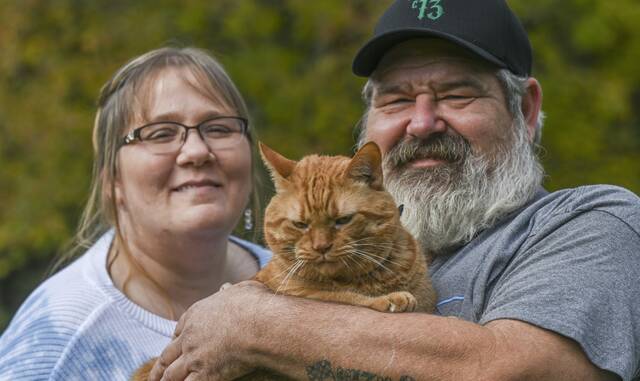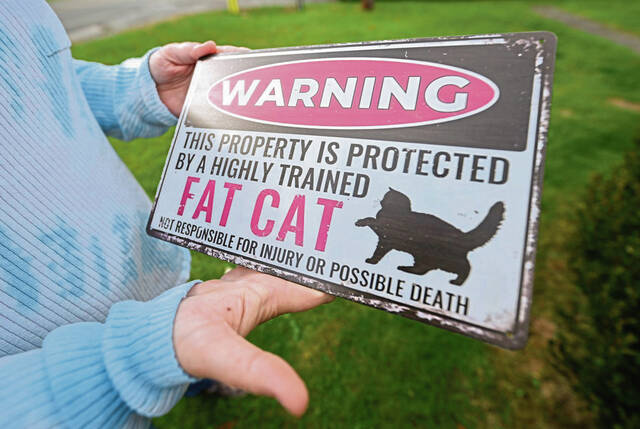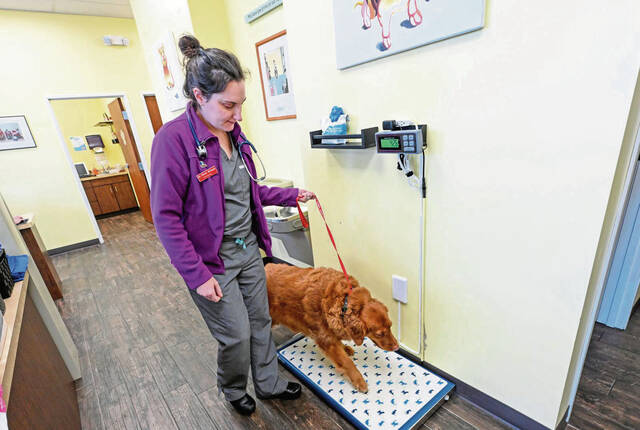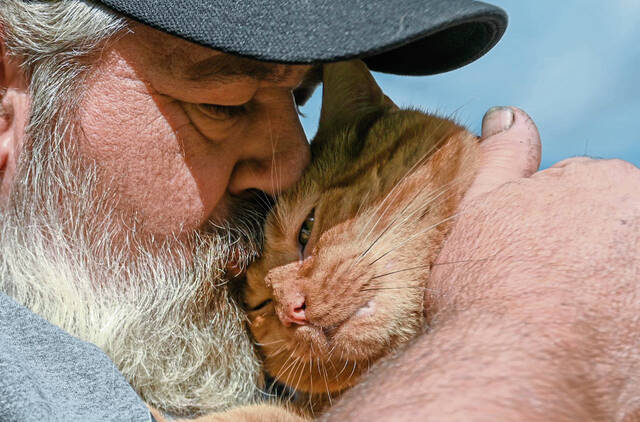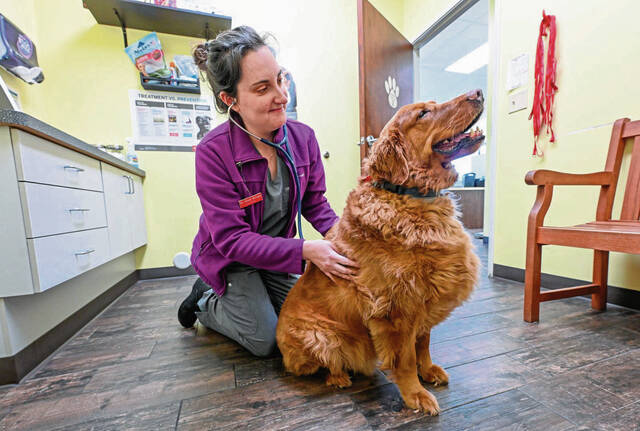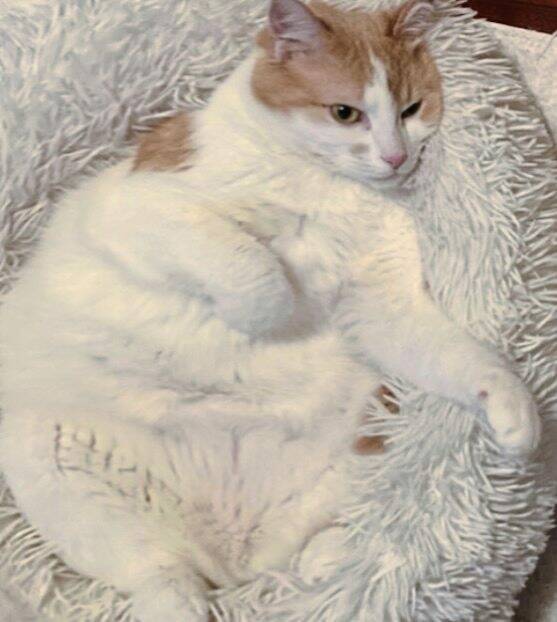Obesity a national epidemic among cats and dogs, experts say
Pudgy pets are a problem in America.
According to the Association for Pet Obesity Prevention, a shocking 56% of dogs and 60% of cats in the U.S. are classified as overweight or obese.
World Pet Obesity Week occurred in October. Veterinarian Dr. Nicole Milligan, owner and operator of Sarver Animal Hospital in Buffalo Township, said she’s seeing unprecedented numbers of obese pet patients at her practice.
“In our practice, I think the prevalence is higher than that (pet obesity statistics), and it’s the most common abnormal exam finding among the dogs and cats we see,” Milligan said. “We have to discuss this with pet owners multiple times, every day, and make recommendations to try and help with weight loss.”
Livin’ large
Click the cat is 22 pounds of solid fluff and doesn’t miss a meal at his home in South Buffalo Township.
The orange tabby feline enjoys the good life, complete with his own personal recliner.
Corie and Mike Roberts rescued Click when they were searching for one of their missing cats who slipped out the door.
Mike Roberts responded to a woman who found a cat matching the missing cat’s description. He returned home with an orange cat, only it wasn’t their missing feline.
“We named him Click because when you click, he comes running,” Corie Roberts said. “He literally has us wrapped around his paw.”
Click enjoys eating Purina One cat food, Fancy Feast Gravy Lovers wet cat food and Temptations treats.
“We do try to limit his treats and wet food,” Corie Roberts said.
But the Robertses admit they don’t want to get criticized by folks about Click’s generous girth.
“We tend to avoid the vet sometimes because they are not happy about his weight, and we’re not really willing to withhold food from him and listen to his meowing nonstop,” Corie said.
Click is known to make a feline fuss when his food bowl is low.
“Food is happiness to Click, and we can’t bear to take his happiness away from him because we adore him,” Corie Roberts said.
Dr. Milligan explained that often reasons for obesity in pets can mirror what we see in people.
“Pets are more sedentary so they aren’t burning as many calories, but the bigger problem is most pets just get too many calories,” Milligan said. “And it may just be instinctual for some animals to act hungry all of the time. If food is available, most will eat it as the body doesn’t know when the next meal will be.”
Commercial pet foods are nutritionally dense, and pet owners often inadvertently give their pets more food than they actually need to fulfill their caloric requirements.
“Many owners give excessive treats and table scraps,” Milligan said. “And that tends to be the biggest contributor to weight gain.”
Milligan recognized the struggle many pet owners face regarding guilt over the amount of food they provide their pets.
“We never want owners to feel bad about having overweight or obese pets because we know most of the time the overfeeding comes from loving their pets so much. Dogs and cats love to get treats, and owners love to see their pets happy,” she said.
Increased medical issues
Ollie is an orange-and-white 12-year-old cat recently diagnosed with feline diabetes.
“I had no idea that was even a thing that existed at first,” said Ollie’s owner Hannah Patterson of Indiana, Pa. “His diagnosis has me taking extra precautions in order to hopefully get him into remission and have a healthier lifestyle.”
Patterson had noticed a change in Ollie’s lifestyle — frequent urination, acting lazy and drinking water more often — and sought medical treatment for her beloved childhood pet.
“The vet told me Ollie was overweight (at 14 pounds) and needed to lose weight in order to become healthier,” Patterson said. “Ollie is the sweetest boy and so cuddly. He’s always been very food-motivated, always waiting by his food bowl and eating very quickly.”
Patterson is hopeful Ollie will go into remission with the right combination of care and meds.
Ollie’s diabetes numbers were “off the charts.” Since then, Patterson has adjusted Ollie’s eating patterns by limiting food intake and times, feeding him a prescribed diet for diabetic felines and administering insulin shots.
Helping Ollie doesn’t come cheap.
The prescription cat food costs $75 per 8-pound bag, and monthly insulin and syringes cost more than $100 combined.
Patterson hopes sharing Ollie’s story will help other others.
“My message to pet owners is to keep an eye on your pet’s weight and water and food intake,” she said. “If you have a concern, seek out a veterinarian to get answers.”
To date, Ollie has lost one pound, more than 7 percent of his body weight.
“It’s very hard because I worry about him, but I also know I’m doing everything I can. It can be stressful, as I need to make sure I’m home every morning and evening to give him his insulin injections,” Patterson said. “Paying for insulin/food isn’t cheap, but he’s truly a member of my family, and there isn’t anything I wouldn’t do for him. I know many other pet parents probably feel the same way but with how expensive things are nowadays, I’ll admit that it can be difficult.”
Potential health risks that may develop in an overweight pet are shortened life expectancy, increased strain on joints — which can worsen underlying arthritis — a higher risk of joint injury and an increased risk of diabetes and heart disease.
Bunny the rescue dog is 2 years old and weighs in at a portly 50 pounds.
He was rescued by the Halter family of Hyde Park after being found emaciated underneath a mobile home.
The tiny pup that once fit into the palm of Amy Halter’s hand ran with a bunny-style hop and the name stuck.
But Halter is dealing with a bit of vet shame as she is set to take Bunny in for a checkup in the coming months.
The family began restricting Bunny’s dry food intake about six months ago, but he remains pudgy.
“The vet says he’s about 20 pounds overweight,” Halter said. “Within the last six months, we realized this isn’t puppy weight, and it just won’t come off. We’re controlling what he eats and the amount.”
Bunny received nonfood treats such as positive attention and toys instead of edible treats and bones.
Halter said Bunny lacks motivation and isn’t active like his dog sibling, Max, who is lean and very active.
“We have to give Bunny a boost to help him get on the couch,” Halter said. “I think for Bunny it’s behavioral, and he tries and makes up for being so small (3 pounds) when we found him. He even tries to take his food and bury it.”
“He’s not a running dog and he’s heavy so the exercise is not enough,” Halter said.
The Halters are hopeful that, in time, Bunny will trim down and increase his physical activity as he loses weight.
“Bunny is not very happy about the whole ordeal. He scratches and nudges at his empty food bowl,” Halter said.
Mr. Waffles is a 22-pound cat from Bloomfield known for his feisty feline demeanor when it pertains to mealtimes.
“The tantrums for what he wants to eat involve drawing blood a lot of the times,” said family member Shannon Lyons of Oakmont. “I’ve personally been the victim of the wrath of not meeting his demands.”
Mr. Waffles is currently on a diet. Family members describe him as a “loaf.”
But the good news is that by having his food limited, he’s shed two pounds in two years.
“My mom, bless her, has been trying to stick to a diet for Mr. Waffles, but it’s a daily struggle,” said Lyons. “Picture my mom telling him ‘no,’ and Mr. Waffles immediately throwing a tantrum like a toddler.”
Family members describe Mr. Waffles’ weight conundrum as a “hot mess express train ride” and point out his large cat “caboose” in photos.
Milligan noted Mr. Waffles obviously likes the taste of food.
“And like we do, animals will eat more than what their body needs,” she said.
Feline fitness encouraged
Gina and Joe Henry of Springdale have four cats including Mrs. Riley, 4, weighing in at 19 pounds.
“The vet told me she should weigh about 13 pounds,” lamented Gina Henry.
The family took measures to ramp up fitness among their felines by transforming a spare bedroom into a cat exercise room, complete with a special feline exercise wheel (think hamster wheel, but for cats) and climbing ledges.
But apparently Riley isn’t too impressed.
“She won’t use the wheel,” Gina said.
The couple have resorted to feeding their other three cats on the kitchen counter, not their first choice but one of necessity, they said.
Pudgy Riley is unable to jump up high enough to reach the countertop.
She was rescued by the Henrys after being found in a drain pipe in Kittanning.
“We try to keep the dry food away from her, but we have to feed all of our cats. Riley has always had signs of food insecurity, and she always wants food,” Gina said.
Riley was switched to Blue Buffalo dietary cat food at her vet’s suggestion two years ago and has since lost a pound.
The vet was thrilled with her weight loss, the couple said.
Sheriff Farley is their special-needs cat that has a few pounds to lose.
Farley suffered a traumatic brain injury during dental surgery and is lucky to be alive.
“He was given a 7% chance to live and made it, but has some behavioral issues. It makes it harder to worry about weight loss with him,” Gina said.
Feline foodie
Freddy of Kiskiminetas Township is not yet 2 and weighs almost 17 pounds.
Owner Amber Peters said Freddy is a big “foodie” and previously ate plenty of cat treats and enjoyed a never-empty food bowl.
But times have changed for the Peters household, home to eight cats.
“Every time I stand up in the living room, Freddy thinks he needs to eat,” Peters said.
Freddy was found by Peters in the parking lot of a Dollar General.
After they adopted him, Peters noticed his pronounced weight gain about six months ago. She began feeding her cats in the morning and evening and greatly limiting cat treats.
Peters said the changes in Freddy’s diet have resulted in him maintaining his current weight and not gaining any more.
“I’d be happy with him staying at his current weight. He’s happy and lovable.”
Joyce Hanz is a native of Charleston, S.C. and is a features reporter covering the Pittsburgh region. She majored in media arts and graduated from the University of South Carolina. She can be reached at jhanz@triblive.com
Remove the ads from your TribLIVE reading experience but still support the journalists who create the content with TribLIVE Ad-Free.


